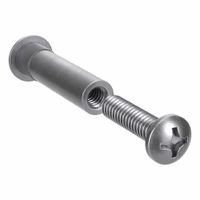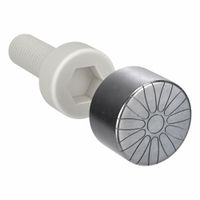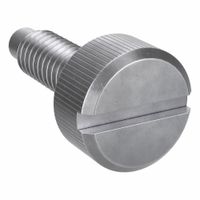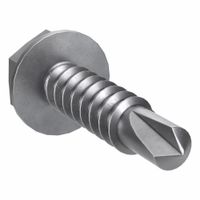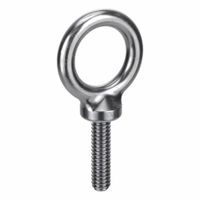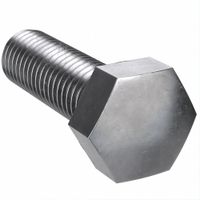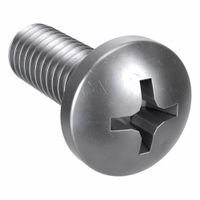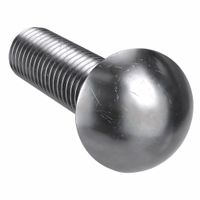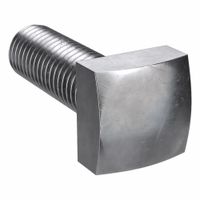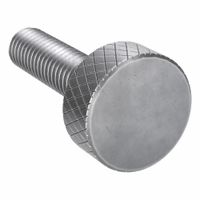Call +(254) 703 030 000 / 751 483 999 / 721 704 777
.....Read More
Frequently Asked Questions
What is the difference between a bolt and a screw?
A bolt is typically used with a nut for fastening, and it is inserted through a hole in the materials being joined. It has a threaded shaft and a head, and its primary function is to create a secure connection through tension when the nut is tightened. Screws, on the other hand, are designed to thread directly into a material, creating their own mating threads or utilizing pre-drilled holes. They are often tapered at the tip and have a head that can be driven by a screwdriver or wrench, forming a connection through friction and compression. While both are fasteners, their fundamental difference lies in their application: bolts rely on a nut for clamping force, whereas screws create their own engagement with the material.
How do you choose the right bolt or screw for a project?
Choosing the right bolt or screw involves considering several factors to ensure proper fastening and structural integrity. First, assess the material being joined. Different materials require specific fastener types; for instance, wood screws are optimized for wood, while machine screws are used with nuts or tapped holes in metal.
Next, consider the application's environment. Will the fastener be exposed to moisture, chemicals, or extreme temperatures? This will dictate the material of the fastener, such as stainless steel for corrosion resistance or hardened steel for strength.
Determine the required holding strength. This involves evaluating the load the fastener will bear (shear and tensile forces). The diameter, length, and thread type of the fastener will influence its strength. Coarse threads are generally stronger and faster to install, while fine threads offer better vibration resistance.
The type of head is also important, as it impacts torque transmission and flushness. Common head types include Phillips, slotted, Torx, and hex, each requiring a specific drive tool. Finally, consider aesthetics and cost, as these can be minor but relevant factors in the overall project.
What are the different types of screws and their uses?
Screws are essential fasteners, each designed for specific applications. Here are some common types and their uses: * **Wood Screws:** Featuring a tapered shank and coarse threads, these are designed to grip wood fibers firmly. They are commonly used in carpentry, furniture assembly, and general wood construction.
* **Machine Screws:** These have a uniform diameter and fine threads, made to mate with pre-tapped holes or nuts. They are widely used in metal-to-metal connections, electronics, and machinery where a precise, strong joint is required.
* **Self-Tapping Screws:** These screws can create their own threads as they are driven into a material. They are frequently used in plastics, sheet metal, and other soft materials, eliminating the need for pre-drilling and tapping.
* **Drywall Screws:** Recognized by their sharp point and coarse threads, these are specifically designed to secure drywall to wood or metal studs. Their unique head design helps them sink flush with the drywall surface.
* **Lag Screws (Lag Bolts):** Larger and more robust than typical wood screws, lag screws have a hexagonal head and coarse threads. They are used for heavy-duty wood applications, such as framing, deck construction, and securing ledger boards, where high strength is needed.
* **Sheet Metal Screws:** These have sharp points and threads that extend to the head, designed to cut into and fasten sheet metal. They are used in HVAC systems, automotive repairs, and various fabrication projects.Choosing the correct screw type ensures a secure and durable connection for any project.
How do you measure a bolt or screw?
To accurately measure a bolt or screw, you need to consider several key dimensions. First, determine the diameter. For bolts, this is typically measured across the threaded shank. For screws, especially wood or sheet metal screws, it's often the widest part of the unthreaded shank or the outer diameter of the threads. Next, measure the length. This is usually taken from the point where the head seats against the material to the tip of the bolt or screw. For flat-head or countersunk screws, the length is measured from the top of the head to the tip. For most other head styles, measure from under the head to the tip.
Another important aspect is the thread pitch or count. For imperial fasteners, this is the number of threads per inch (TPI). For metric fasteners, it's the distance between adjacent threads (pitch), measured in millimeters. You'll also want to identify the head type (e.g., hex, Phillips, flat, socket) and drive type (e.g., slotted, Phillips, Torx). Finally, note the material and finish, as these affect strength and corrosion resistance. Tools like calipers or a thread gauge can help you get precise measurements.
What materials are bolts and screws made from?
Bolts and screws are typically made from a variety of materials, each chosen for specific properties like strength, corrosion resistance, and cost. Common materials include various types of steel, such as carbon steel, alloy steel, and stainless steel. Carbon steel is widely used for its strength and affordability. Alloy steels, like those containing chromium or molybdenum, offer increased strength and hardness. Stainless steel, available in grades like 304 and 316, is preferred for its excellent corrosion resistance, making it suitable for outdoor or marine applications.
Beyond steel, other materials are also used. Brass and bronze are often chosen for their corrosion resistance and electrical conductivity, while aluminum is used when lightweight fasteners are required. Nylon and other plastics are employed for applications where electrical insulation, light weight, or non-corrosive properties are critical. The choice of material ultimately depends on the specific demands of the application, including the environment, load requirements, and desired lifespan.
How do you prevent bolts and screws from loosening?
Preventing bolts and screws from loosening is crucial for maintaining the integrity and safety of many assemblies. Several methods can be employed, often in combination, depending on the application's specific needs.
One common approach involves using mechanical locking devices. Lock washers, such as split lock washers or external tooth lock washers, are designed to create friction or dig into the mating surfaces, resisting rotation. Nylock nuts, which incorporate a nylon insert, provide resistance against loosening by deforming around the bolt threads. Castle nuts, when used with a cotter pin through a hole in the bolt, physically prevent the nut from backing off.
Another effective strategy is to increase the friction between the fastener and the joint. This can be achieved using thread-locking compounds, commonly known as threadlockers. These anaerobic adhesives cure in the absence of air and in the presence of metal ions, filling the microscopic gaps between threads and creating a strong bond that resists vibration and shock. Different strengths of threadlockers are available, ranging from low strength for easy disassembly to high strength for permanent assemblies.
Proper torque application is also paramount. Under-torquing can lead to insufficient clamping force, making the fastener susceptible to loosening, while over-torquing can stretch the bolt or damage the threads, also compromising the joint's stability. Using a torque wrench ensures that fasteners are tightened to the manufacturer's specified value.
Finally, consider the material properties and environmental factors. Vibration, thermal expansion and contraction, and corrosion can all contribute to fastener loosening. Selecting appropriate materials, surface coatings, or using vibration-damping elements can help mitigate these issues.
What is the purpose of a socket head cap screw?
A socket head cap screw is a type of threaded fastener characterized by its cylindrical head and hexagonal recess (socket) for driving with an Allen wrench or hex key. Its primary purpose is to secure components together, particularly in applications where a strong, precise, and compact fastening solution is required.
These screws are commonly used in machinery, automotive, and manufacturing industries due to several key advantages: * **High Tensile Strength:** Socket head cap screws are typically made from high-strength steel alloys, allowing them to withstand significant tensile loads without stretching or breaking. This makes them ideal for critical structural applications.
* **Compact Design:** The internal hex drive allows for a smaller head diameter compared to external hex head bolts, which is beneficial in space-constrained assemblies.
* **Aesthetic Appeal:** The flush-fitting head, when properly countersunk, provides a clean and streamlined appearance, often preferred in designs where aesthetics are important.
* **Durability and Reusability:** Their robust construction and precise manufacturing ensure long-term durability and the ability to be repeatedly assembled and disassembled without significant wear.
* **Reduced Risk of Stripping:** The hex drive offers better torque transmission and reduces the likelihood of cam-out (slipping of the driver from the fastener head) compared to Phillips or slotted drives, especially in high-torque applications.In essence, a socket head cap screw provides a reliable and efficient method for creating strong, secure, and visually appealing connections in a wide range of engineering and industrial applications.
How do you install a self-tapping screw?
Installing a self-tapping screw is a straightforward process, but it requires proper technique to ensure a secure and durable fastening. Unlike regular screws, self-tapping screws are designed to tap their own threads as they are driven into a material, eliminating the need for a pre-drilled pilot hole in many cases.
The first step is to select the correct self-tapping screw for the material you are working with. Different materials, such as metal, plastic, or wood, require specific screw types and thread designs for optimal performance. Once you have the right screw, position it at the desired location on the material.
Next, using a power drill or a screwdriver, apply steady, downward pressure while rotating the screw. The tip of the self-tapping screw will begin to cut into the material, creating its own threads. It's important to maintain a consistent speed and pressure to avoid stripping the screw head or damaging the material. As the screw penetrates deeper, you will feel it bite into the material and start to pull itself in.
Continue driving the screw until it is fully seated and flush with the surface of the material, or until it reaches the desired depth. Be careful not to overtighten, as this can strip the threads or crack the material, compromising the integrity of the fastening. A good indication of proper tightening is when the screw feels snug and secure without any play.
For harder materials or specific applications, a small pilot hole might still be beneficial to guide the screw and prevent splitting, even with self-tapping screws. Always refer to the manufacturer's recommendations for the specific screw and material you are using to ensure the best results.
What are shoulder screws used for?
Shoulder screws, also known as shoulder bolts or stripper bolts, are fasteners with a cylindrical shoulder or unthreaded shank larger in diameter than the threaded portion. This unique design serves several key purposes: * **Pivoting and Rotary Applications:** The unthreaded shoulder acts as a bearing surface, allowing components to rotate or pivot smoothly around the screw without binding. This is common in linkages, levers, and moving parts where precise alignment and reduced friction are critical.
* **Guiding and Alignment:** The accurate diameter of the shoulder can be used to precisely align two or more parts, ensuring they remain in the correct relative position during assembly or operation. They can also act as guides for linear motion.
* **Controlling Movement:** The shoulder's length can control the amount of travel or movement of a component. For instance, in die sets, they can limit the travel of stripper plates.
* **Spacers and Stand-offs:** The shoulder can act as a built-in spacer, maintaining a specific distance between two components, eliminating the need for separate washers or stand-offs.
* **Mounting Bearings:** They are often used to mount bearings, where the shoulder provides a snug fit for the inner race of the bearing.Due to their versatility and precision, shoulder screws are widely used in a variety of industries, including machinery, automation, automotive, and consumer electronics.
How do you remove a stripped screw or bolt?
Removing a stripped screw or bolt can be a common frustration, but several methods can help. One popular technique involves using a screw extractor kit. These kits typically include drill bits and extractors; first, you drill a pilot hole into the center of the stripped head, and then you insert the extractor, which has a reverse thread, and slowly turn it counter-clockwise to bite into the screw and back it out.
Another method is to use a rubber band or steel wool. Place a wide rubber band or a piece of steel wool over the stripped head, then insert your screwdriver bit into the rubber or steel wool. The added friction can sometimes give the screwdriver enough grip to turn the screw.
For screws that are only slightly stripped, a larger or different type of screwdriver bit might work. For instance, if a Phillips head is stripped, sometimes a larger flathead screwdriver can be wedged into two of the opposing grooves to create enough torque.
If the screw is protruding, you might be able to grip it with a pair of locking pliers (Vise-Grips). Clamp the pliers firmly onto the head or exposed shaft of the screw and slowly twist it out.
For very stubborn or completely rounded-out screws, grinding a slot into the head with a rotary tool (like a Dremel) can create a new flathead slot, allowing you to use a flathead screwdriver. Always wear safety glasses when using power tools.
